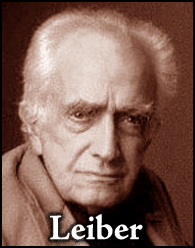Friday, March 27, 2009
posted by Steve Trout
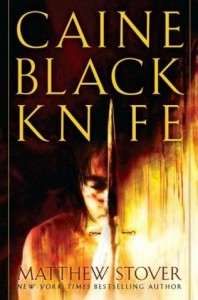
Or Kane. Or Cain. The primordial killer, Caine is back. If you think Howard is grim, Wagner is dark, Adam Colby (whoever the heck that is) is bleak, try Stover, and especially Caine, the reality show for people who can’t stand reality.
Actually, this book has been out since last October, but with all the Howard coming out I haven’t been able to keep up with my other favorites so well as I’d like. Stover has been wasting his time and talent with Star Wars novels so much lately, this one kind of snuck up on me.
The Caine books are that rarity that tries to put science fiction and fantasy into the same story and actually doesn’t come off as lame.
(Continue reading this post)
Friday, March 27, 2009
posted by Leo Grin

Just a heads-up to all Howard fans out there looking to increase their holdings of REHupa mailings. In the coming days I will be posting a bunch for sale. The first five are already up, with more to follow in the coming days. For information about why REHupa mailings are so collectible, go here.
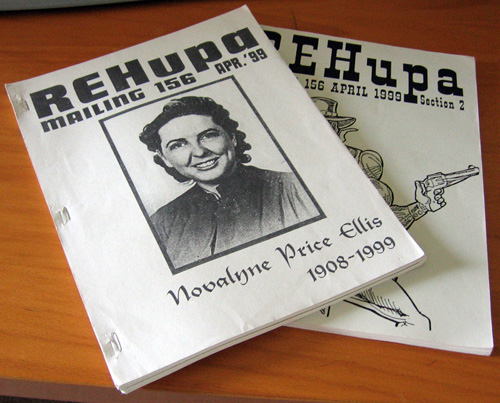
Also, for those of you looking to complete your Deluxe sets of The Cimmerian, there have been some lots for sale at eBay that include some of the out-of-print issues you are looking for. The latest is here.
Wednesday, March 25, 2009
posted by Deuce Richardson
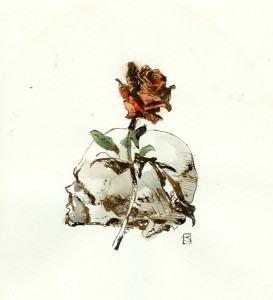
Today, right in the midst of a domicilic transition, The Collected Poetry of Robert E. Howard landed on my doorstep. Knowing the consequences of giving in to temptation, I steeled my will and carried on carryin’ on the washer and the fridge and the bookcases…
Night has fallen and I now give myself a most just reward, drinking deep from the cup of Howard’s poetic genius.
(Continue reading this post)
Tuesday, March 24, 2009
posted by Steve Trout
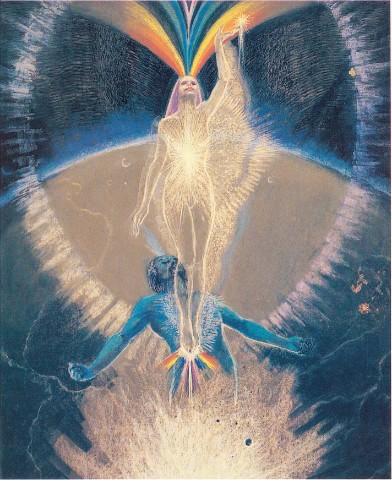
From the very beginning of his career, up to the very end, Robert E. Howard wrote stories that involved a man and a woman and a third force that had to be overcome before they could be together. The man, strong and often dark, was Howard’s projection of his self to some extent, and the woman, often blonde, was a projection of his anima, the standard version involving a feminine aspect. From the early days of “Spear and Fang” and “The Hyena” to later works like “Red Nails” and the novelized GENT FROM BEAR CREEK, this “boy meets girl, boy loses girl temporarily to dark menacing Other, boy wins girl” story line appears quite frequently. The dark menacing Other is the shadow. But as has been pointed out by critics like Leslie Fiedler and Richard Slotkin, an unusual aspect of American classic literature is the frequency with which the dark menacing Other becomes the anima; or takes its place.
(Continue reading this post)
Wednesday, March 18, 2009
posted by Deuce Richardson
“Saint Padraic’s Day usually leaves me with a distaste for the whole Celtic Irish race.” Robert E. Howard, from a letter to Harold Preece, ca. early April, 1930.
Howard’s Hibernophilia is hard to contest, but reading the above quote might cause one to wonder. In context, the meaning becomes much clearer. 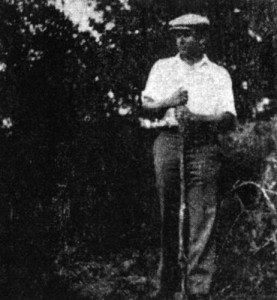 REH (whose photo to the left could easily be that of a “Black Irish” workman of the early twentieth century) noted the “questioning glances” of fellow Texans “who wear purely Gaelic surnames.” His response to such affronts was that, “I’ll wear the green if I have to fight every damned Celt in the world.” A suitably pugnacious Howardian (and Celtic) attitude, in my opinion.
REH (whose photo to the left could easily be that of a “Black Irish” workman of the early twentieth century) noted the “questioning glances” of fellow Texans “who wear purely Gaelic surnames.” His response to such affronts was that, “I’ll wear the green if I have to fight every damned Celt in the world.” A suitably pugnacious Howardian (and Celtic) attitude, in my opinion.
Howard was always ambivalent in his regard for the Irish. In another letter to Preece, REH wrote, “Damn the Irish and damn the black Milesian blood in my veins that makes me like drift-wood fighting the waves and gives me no peace or rest waking or sleeping or riding or dreaming or traveling or wooing, drunk or sober, with hunger or slumber on me”. Again and again REH railed against the waywardness and instability that he saw in the Celtic psyche. “What has my Celtic blood ever done to me but give me a restless and unstable mind that gives me no rest in anything I do”? Obviously, despite Robert E. Howard’s heart-felt pride in his Irishness (the true extent of that Irishness is something Patrice Louinet is researching even now), he didn’t view Erin nor her children through green-tinted glasses, at least not in every instance. (Continue reading this post)
Wednesday, March 18, 2009
posted by Leo Grin
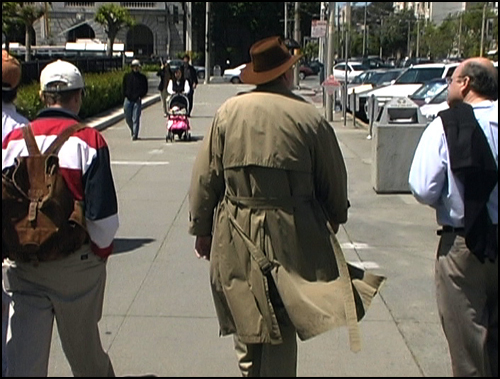
Don Herron’s The Dashiell Hammett Tour: Thirtieth Anniversary Guidebook is released
Don Herron is the best critic in Howard studies, bar none. However, REH is but a small part of his professional output. He’s most famous for helming the longest-running literary walking tour in the US, San Francisco’s Dashiell Hammett Tour. Over three decades it has become a Bay Area institution and a must-do for mystery fans and literati alike. In 1991 City Lights, Lawrence Ferlinghetti’s legendary counterculture imprint, published Don’s The Dashiell Hammett Tour: A Guidebook, which garnered great reviews and has been much sought after on the used market, often selling for over $100 in fine condition.
Now, Don has released a brand new, fully revised and updated version of his book. Published by Vince Emery as a part of his Ace Performer Collection, a group of titles by and about Hammett, this new edition looks beautiful, and is in hardcover to boot. Don has been running around doing various appearances in support of the release — just in the last few weeks he hit Boise, Idaho; Tuscon and Scottsdale, Arizona; and a bunch of places in and around San Francisco. MSNBC has a write-up of the book’s contents and of Don’s future book signings in the Bay Area. You can also keep up with the action at his website.
All of Don’s books are well worth hunting down — he’s collected, in fact, by the prestigious Bancroft Library at UC Berkeley, an organization that calls him on their website “the godfather of San Francisco mysteries.” But The Dashiell Hammett Tour book occupies a special place in his canon. The tour has been written up hundreds of times in virtually every major newspaper and venue, making it one of the most popular of its kind in the world. It (and Don) even appeared as an answer/question combo on Jeopardy! once. (To bring a bit of Cimmerian flavor into all of this: Don found out about the Jeopardy! thing when his good pal, the fantasy writer Fritz Leiber, called him up with the info. Leiber was a Jeopardy! fiend in his later years and caught wind of the Herron appearance during his usual afternoon viewing.)
So if you are a Hammett fan, or a fan of great literature in general — pick up a copy of the book at Amazon or wherever fine mystery books are sold.
(Continue reading this post)
Friday, March 13, 2009
posted by Steve Trout

Those of us who remember the agonizing wait between new issues of the Watchmen limited series have at last endured through an even more momentous wait – the famed graphic novel has finally been released as a movie. Of course, many elements of the story had to be trimmed or chopped, but as a Cliff Notes version, it’s a very faithful adaptation, for the most part. Like the makers of the so-called Bram Stoker’s Dracula, though they are doing great right up to the end, they feel they have to have at least one really significant change. Don’t ask me why.
(Continue reading this post)
Wednesday, March 11, 2009
posted by Deuce Richardson

“Know, oh prince, that between the years when the oceans drank Atlantis and the gleaming cities, and the years of the rise of the sons of Aryas, there was an Age undreamed of… (…) Hither came Conan the Cimmerian… “
– The Nemedian Chronicles
In December, 1932, the words above first introduced Conan the Cimmerian and his Hyborian Age to twentieth century America. Readers from every generation since have been intrigued by that heading from Chapter I of “The Phoenix on the Sword.” In a previous post, I discussed just what Robert E. Howard might have meant by “the sons of Aryas.” Why would a ‘Nemedian chronicler’ from Hyborian Age Nemedia speak of the Hyborian Age as “an Age undreamed of”?
(Continue reading this post)
Sunday, March 8, 2009
posted by Steve Tompkins
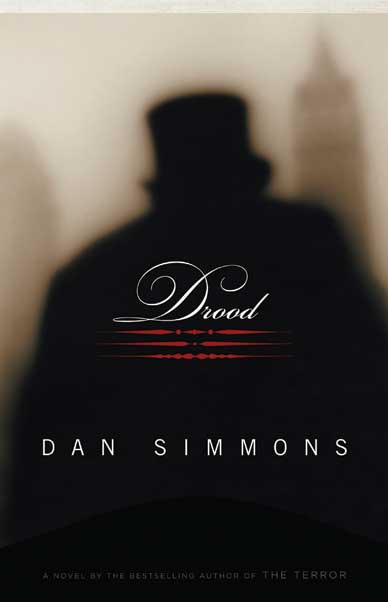
Dickens was meant by Heaven to be the great melodramatist; so that even his literary end was melodramatic. Something more seems hinted at in the cutting short of Edwin Drood by Dickens than the mere cutting short of a good novel by a great man. It seems rather like the last taunt of some elf, leaving the world, that it should be this story which is not ended, this story which is only a story. The only one of Dickens’ novels which he did not finish was the only one that really needed finishing…
Dickens dies in the act of telling, not his tenth novel, but his first news of murder. He drops down dead as he is in the act of denouncing the assassin. It is permitted to Dickens, in short, to come to a literary end as strange as his literary beginning.
G. K. Chesterton, Appreciations and Criticisms of the Works of Charles Dickens
Darting come-hither glances at potential posthumous collaborators since Charles Dickens’ death in 1870, The Mystery of Edwin Drood has been completed more often than Form 1040-EZ. Dan Simmons‘ new novel isn’t just another attempt at closure and conclusiveness. Instead, Drood — the heftiness of which, as with The Terror (2007) before it, would better suit a tome intended for the bookstores of Brobdingnag than a burden to be borne by puny, hernia-prone hominids like us — plays with Chesterton’s already playful suggestions of a “melodramatic” or “strange” literary end for Dickens, of an interrupted assassin-denunciation, of the “something more” seemingly “hinted at in the cutting short of a good novel.”
Sometimes I think Harlan Ellison’s last major contribution to the fantastique, the purple-and-gold or black-and-red genres, was his part in the “discovery” of Dan Simmons. The Song of Kali (1985) so lastingly traumatized some of us that while watching Slumdog Millionaire we had to calm ourselves with reminders that Mumbai is a reassuring 1,677 kilometers away from Calcutta. Ever since that first novel, Simmons has succeeded at almost everything he has sought to do – and he has sought to do things undreamed of by even the most imaginative horror, science fiction, and dark fantasy specialists.
(Continue reading this post)
Friday, March 6, 2009
posted by Steve Trout
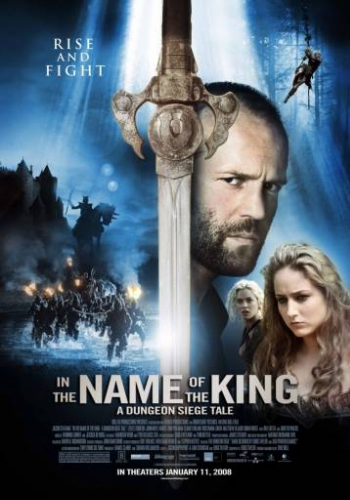
I’m a little surprised that last year’s big-budget Sword & Sorcery epic hasn’t seen any commentary in the Howardian blogosphere, at least not in the forums I visit. Sure, Uwe Boll’s videogame spin-off In the Name of the King was a massive flop, returning around 5% of its $60 million budget on its not-even-in-the-top-ten opening weekend, apparently failing to even draw the game’s fans. (It’s world wide gross is still only $12.5 million or so.) And it undoubtedly deserved to be a flop, being a derivative, muddled and terribly cast example of how not to make a fantasy film — still, it has its moments. Like The Sword and the Sorceror, a sentimental favorite of some older Howard fans, it lends itself naturally to MST3K-style mockery. The director even picked up a Razzie for his efforts, though the film itself lost out to The Love Guru as worst picture. So why even watch this film? Well. . ..
(Continue reading this post)






 REH (whose photo to the left could easily be that of a “Black Irish” workman of the early twentieth century) noted the “questioning glances” of fellow Texans “who wear purely Gaelic surnames.” His response to such affronts was that, “I’ll wear the green if I have to fight every damned Celt in the world.” A suitably pugnacious Howardian (and Celtic) attitude, in my opinion.
REH (whose photo to the left could easily be that of a “Black Irish” workman of the early twentieth century) noted the “questioning glances” of fellow Texans “who wear purely Gaelic surnames.” His response to such affronts was that, “I’ll wear the green if I have to fight every damned Celt in the world.” A suitably pugnacious Howardian (and Celtic) attitude, in my opinion.




